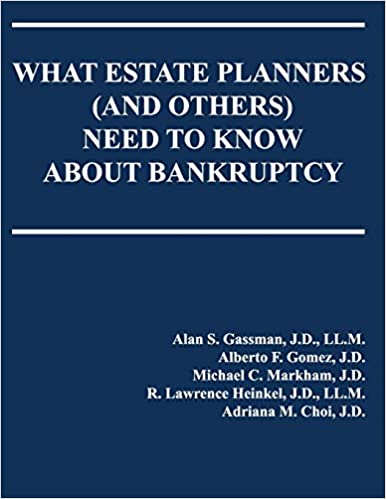As a dedicated estate planner for more years than I care to admit, there’s been one subject that kept surfacing in my practice, then subsiding without leaving much information behind—that subject was bankruptcy and all its related issues. Not that the subject wasn’t important enough for me to research it, it’s just that it’s so specialized and arose so sporadically, it didn’t warrant taking a course in it or hitting any of the mass of heavy volumes on the subject. My own personal wish was, if only there was a manageable, authoritative reference I could use to answer some of the questions that advisors, estate planners in particular, typically confront; such as, what are the special fraudulent conveyance rules in bankruptcy? Can a bankruptcy trustee reach the assets clients place in children’s trusts? Are clients’ limited liability company interests protected in a bankruptcy? Are there some assets that are protected if a client later has to file for bankruptcy? Are there some transfers that are protected if a client later files for bankruptcy? What about asset protection trusts that a client establishes in a state like Delaware or South Dakota?
Answers to These Questions
Finally, there is such a work, just recently published, that addresses all of these and the numerous related questions. Attorney Alan Gassman, along with Alberto Gomez, Michael Markham, Adriana Choi and Lawrence Heinkel, have accomplished what might appear to be an impossible task: to analyze the numerous issues generated in a bankruptcy proceeding from a tax and estate-planning viewpoint, and they do it in about 150 pages.
Two of the more common issues planners typically face when a client faces or is contemplating a bankruptcy filing are the question of preferential transfers and exposure to fraudulent transfers. A preferential transfer is often distinguished from a fraudulent transfer on the basis that a fraudulent transfer by definition is one in which the client/transferor doesn’t receive fair value for the transfer. Clearly, an outright gift, for example, or the “sale” of a $50,000 asset for $7,500, would be a fraudulent transfer, but when a client pays off a legitimate $50,000 note due to his parents just months before filing bankruptcy, that’s what’s known as a preferential transfer, and as the Gassman group tells us, the bankruptcy court can order the parents to return the payment to the court to be counted with the client’s other assets. Thus, a planner’s advice to a client that he should pay off certain debts before filing would be bad advice and could result in a claim against the planner. But what if the client, who is about to file bankruptcy, owes fees to the planner. May these fees be paid before bankruptcy? According to the Gassman group, “reasonable compensation paid for services rendered will not be considered a preferential transfer, and so should be permitted,” but that rule probably wouldn’t apply, for example, to a previous outstanding debt to the planner.
The list of topics is exhaustive, and there are plenty of cites if one wishes to research the topic as well as a brief discussion of key cases on many issues. The book is truly unique in its practical and informative coverage of so many estate-planning points related to bankruptcy. I recommend it highly as a reference that belongs in every estate planner’s library.
 What Estate Planners (and Others) Need to Know About Bankruptcy
What Estate Planners (and Others) Need to Know About Bankruptcy
By Alan Gassman, Alberto Gomez, Michael Markham, Adriana Choi, Lawrence Heinkel
Available on Amazon, $159.99
Haddon Hall Publishers





